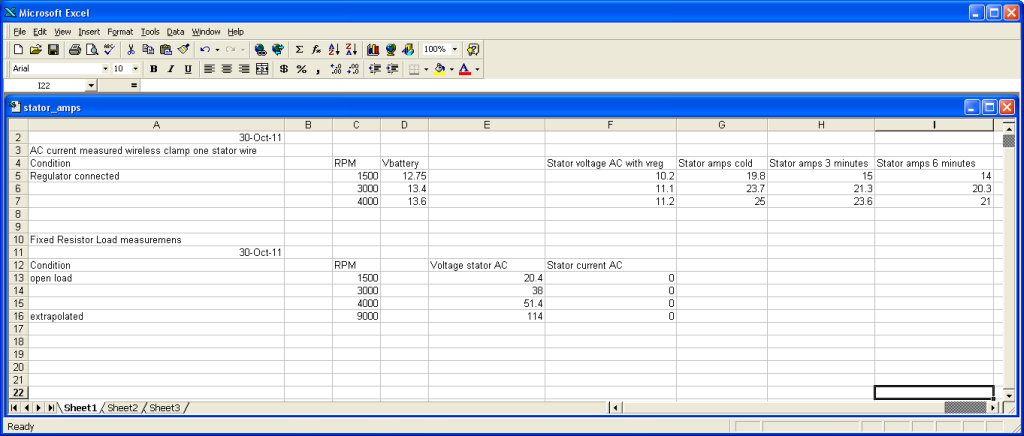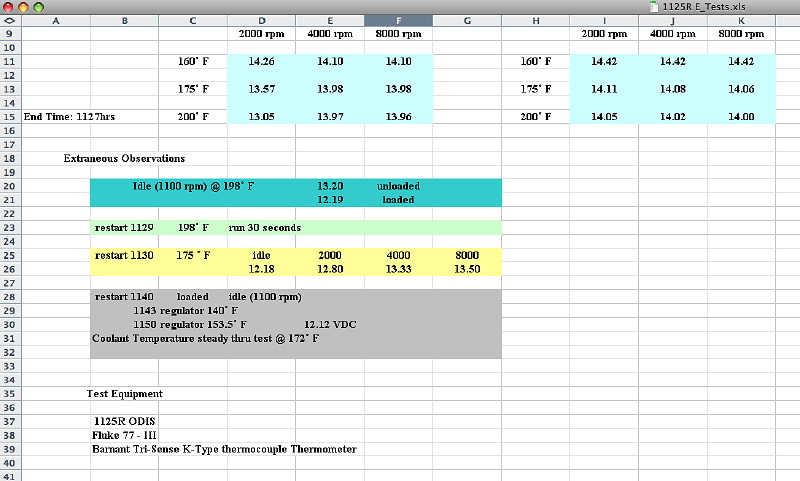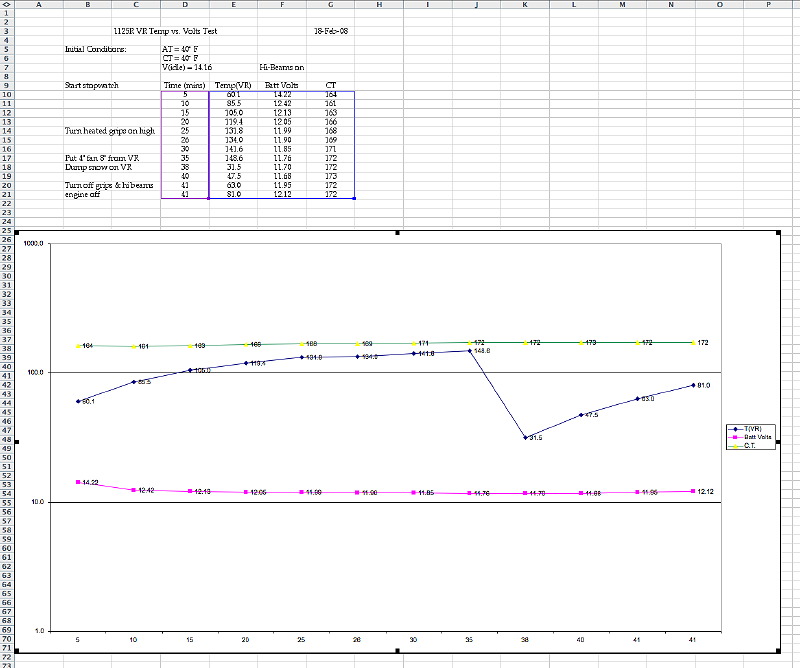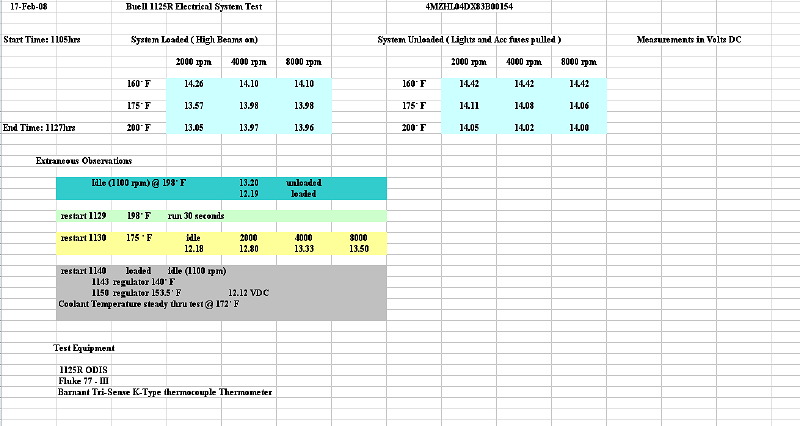| Author | Message | ||
Nightsky |
Top half of table shows measurements taken with stock Ducati shunt vreg connected. The vreg clamps stator output to about 11VAC. Current is measured with bike cold, again after estimated 3 minutes, 6 minutes. Current drops as stator core material heats up and loses magnetic permeability. Current is measured as amps AC using an induction meter around one stator leg. Since two windings share each stator leg, a correction factor of 1.5 must be used to account for the third winding. Lower table measures stator voltage with regulator disconnected. Unloaded open circuit stator voltage is measured. I'll use 3000 RPM and 6 minutes as an example to calculate stator power output and heat. Stator voltage drop is the non load voltage minus the voltage clamped by shunt vreg (38 - 11.1). Multiplying by 20.3 amp current and 1.5 correction factor for 3rd winding give us: (38 - 11.1) * 20.3 * 1.5 = 819 watts stator heat at 3k RPM (51.4 - 11.2) * 21 * 1.5 = 1,260 watts stator heat at 4k RPM I've extrapolated no load stator voltage at 9k RPM using Farady's law. The reader may want to calculate 9k RPM stator heat using 11.2 volts and 21 amps. At 4k RPM, your stator is robbing 1.2 kilowatts (1.7 horsepower, 746 watts per HP) from your bike's power and destroying itself with the generated heat. That is why these stators with shunt regs don't last without oil cooling.  | ||
Sparky |
That's revealing. But are you testing a 2008 charging system and concluding that heat destroys these stators or am I missing something? I thought it had been established that 2008 stators don't self destruct like the '09/'10s do. | ||
Timebandit |
It would be really interesting to take identical measurements off of a 2009 and quantify/compare the amount of thermal insufficiency in the charging system for both years. That, combined with the pseudo-MTBF data that's been accumulated on the forum, might help to give us a better idea of just how much more reliable the 2008 charging system really is. The failure reports suggest that everyone is giving the nod to the 2008 system just because it isn't overtly failing like the 2009 system has been. Of course, that isn't equivalent to saying that the 2008 system isn't going to fail. In the big scheme of things, it's only 2011 now. The 2008 system hasn't been around that long, and pronouncing it as being bulletproof may be a bit premature. Time will tell. What the data does appear to show us is that the 2009 charging system definitely has problems, and they've become manifest frequently enough to identify a problem with the 2009 system. Clearly, the 2009 system has an unacceptably low MTBF. Of course, the fact that the 2008 systems aren't failing during warranty tells us nothing about the long-term reliability of the 2008 systems -- it just tells us that the 2008 MTBF is probably greater than the warranty period. The truth is that no charging system has an MTBF that is infinite. Every MTBF is finite and measurable. The question is just whether or not we've had the 2008 system in service long enough to see the problems. It's an accepted fact that all shunt-regulation paradigms eventually cause stator failure. It's not a question of IF the 2008 charging system will fail, it's a question of WHEN. There's no doubt that the 2008 system hasn't been failing as quickly as the 2009 system, but I wouldn't go so far as to say that it's been established that 2008 stators don't burn themselves up like 09/10s do. It's not that the stators self-destruct, it's that the shunt regulator and the lack of engine cooling destroys one type of stator faster than the other, and the one that's dying first is the one that has the higher output. That's exactly what we should be expecting under shunt regulation. With that said, those 2008 thermal efficiency numbers aren't pretty to look at. I'd really like to see some 2009 number for comparison. Anybody got them? | ||
Timebandit |
Hey Nightsky -- you running a 16 year-old version of MS Excel?!?  | ||
Froggy |
Can you name even *one* person that has had an 08 stator fail? I'm sure its happened statically, as like you say nothing is indestructible. But for every 08 failure, I'm sure there is something like a thousand 09 failures. For what its worth, I have both an 08 and 09, both with similar mileage and riding conditions, the 09 had the stator fail several times, the 08 is still all original. Both still have the stock VR, I don't plan on touching it unless they by some chance fail. | ||
Nightsky |
Opps! I revealed myself. I'm cheap. Yes, that is a '97 version of Excel. Hi Froggy. I can't tell you the MTBF (Mean Time Between Failures) of the '08 stator with a shunt reg either. But we can infer from extrapolating the numbers that at 9k RPM the stator dissipates over 3KW of power! This indicates running the bike at high revs will cause a stator failure sooner than low revs. Are you a guy who rides at low revs? | ||
Froggy |
Yep, my bikes rarely if ever see above 4000rpm. I enjoy the bike and roads without breaking the law (usually) Thing is, there are plenty of owners who keep the motor constantly wound up without issue. The issue with the 09/10s was that at lower RPM the stator does not have sufficient cooling. At higher RPMs it does, hence it is recommended to keep it above 5k RPM to prevent failure. | ||
Black |
Interesting discussion, I expect anything, whether electrical or mechanical, to eventually fail. I don't know of any failures of stators on race bikes. I have asked, on this forum, for more detail on how a stator failed. I have had one respondent state that his stator failed with a parted winding. He also stated that he knew of five others. I have also heard on this forum that numerous "failed" stators when returned to the factory, were not failed at all. I have read that an engine light/battery light combo is a sure sign of failure, etc,, etc., All that said, my initial reaction, when this issue first appeared, was that perhaps we had a bad batch of varnish. As numerous units have been rewound, that doesn't appear to be the cause. It is interesting that some persons seem to have numerous stators fail on the same bike over and over again. The shunt regulator discussion is interesting, however, I believe shunt regulators are near universal. With all of that, I try to keep my machines at about mid range when I ride, which one can easily do without breaking the law. I figure that many manufacturers will give you a range for efficient operations, especially with really large engines. That is, RPMs, cooling, etc. Harley says 5 grand. So I try to keep it at or above 5 grand. Unfortunately, most of the data on these failures is hearsay and there is very little actual data with which to determine anything. Well....thanks for doing the math. I'm going to go ride. | ||
Zac4mac |
I did a couple of tests back in Feb of 08.   Testing in my garage shot my fuel economy to hell. Also, the lights were all OEM in the tests, now I run HID lo-beams and rarely use my hi-beams. Charging system is all original as is the battery. 27+k miles. on the road 3 y 11 mos. Zack | ||
Cataract2 |
Zac, what did switching to HIDs do for you electrical wise? | ||
Zac4mac |
No real change Ryan, they are 35W, 6k K. They have a higher startup current but the same running current as the halogens did. Added light output is a godsend to these old eyes. Z | ||
Nattyx1 |
Nightsky: I'm with Froggy here. You're obviously a smart guy... so I'm baffled. Why run these tests on the '08 model when the real issues are with 09/10 models? It's like a doctor having an obviously very sick patient, and then instead of testing him to make an accurate diagnosis, he grabs a similar-looking yet apparently healthy-looking person to test instead. It'd be a great public service if you could do these same tests with a bike that has had the HD harness install and a "currently" (no pun intended) functioning stator. | ||
Timebandit |
> "It's like a doctor having an obviously very sick patient, and then instead of testing him to make an accurate diagnosis, he grabs a similar-looking yet apparently healthy-looking person to test instead." Playing doctor with a healthy patient? Let's not mock the guy just because we don't understand what he's doing. Hey, I've got an idea: Let's grab our pitchforks and torches and burn the mad scientist. It's obvious that he's a witch! But seriously, Nightsky is a smart guy who isn't at all misguided in what he's doing. He isn't playing doctor with a healthy patient. He posted those numbers because Froggy asked for them. The only reason the data is posted here is because Froggy asked to see it. The backstory from his other thread is that Nightsky has a 2008 bike with a charging system that tests OK according to the Buell test specs but it doesn't charge worth a damn and eats batteries. Nightsky is an Electrical Engineer and he's using expert knowledge to solve the problem. It's OK if some of what he's doing might baffle some people who don't have his educational background. I am glad that he's posted the data. I think he's made a very astute observation that's going to be lost on most people. It's going to be difficult for anyone to put into context and truly appreciate until someone who owns a 2009 bike takes similar measurements and posts the data for comparison. Nightsky: Don't feel bad. No good deed goes unpunished. | ||
Nattyx1 |
I meant no disrespect. I commented specifically that I thought he was intelligent. I don't claim to understand everything he wrote because I am not a trained electrical engineer. I admit to being a bit testy because I love this bike and yet hate the idea that it most likely will leave me stranded again... at least until someone like Nightsky figures out a workable solution for the hoi polloi. I apologize if it seemed I was directing my ire about this at NightSky... and fwiw I had no idea that his 08 had a particular charging issue. All I really hoped for in my comment was that he or someone like him would be motivated to conduct similarly exhaustive studies on later model bikes that are inherently flawed with the intention of finding a real solution. To that end, I'll happily offer my bike as a test mule if someone wants to send me whatever equipment I'd need to affix (I'll even spring for the shipping). Our riding season doesn't really ever end here in LA, although on cooler days it is tough to get the engine temp above 200 with normal riding. Again sorry if I offended anyone. | ||
Nightsky |
Zac4mac, Did you really rev your bike up to 8k RPM in the garage? I've been scolded that high revs in neutral damage valves. So I'm looking at this vreg temperature curve that dips down around time 38 minutes, wondering "What happened there?" I fell out of my chair laughing when I read in small print on the plot "Dump snow on VR." I don't understand why battery voltages in teal at top are around 14V, and others below in the 12s. I thought "hot stator", but top teal tables have high coolant temp. Low battery volts must be measurements under load? What is difference between top left and right teal tables? | ||
Timebandit |
I also laughed pretty hard when I saw the "Dump snow on it" entry in the table. Zac has found the definitive method for you to dissipate all of that unwanted stator heat -- dump snow on it! | ||
Black |
"Nightsky is an Electrical Engineer and he's using expert knowledge to solve the problem. It's OK if some of what he's doing might baffle some people who don't have his educational background. I am glad that he's posted the data. I think he's made a very astute observation that's going to be lost on most people." Dude, it is possible for you to be a little less condescending? | ||
Zac4mac |
Yes, I revved to 8k for long enough to get a measurement. The snow was to isolate the heat issue to the VR or stator. VR passed. I see your confusion on the E-test image. cropping error. ooops.  | ||
Blake |
Zac, Off topic question. What is best cost effective multi-meter that includes ammeter? Not looking for pro equipment, just one for occasional use; compact is good. No made in china. | ||
Zac4mac |
Blake I'm real sold on Flukes although they are a bit pricey. I bought mine for a little over $100, probably in 1990. It was a new model 77. Resistance quit working in 1999 and they replaced it with a 77-III. 77-IV lists for 269 these days. I haven't seen one to see where it's made recently. If I had to replace it, I would look at a used 77 or 87. Good luck finding an electronic device NOT made in China, another advantage of a used meter. If you only use the meter in a shop/garage setting, Fluke benchtop meters are like model-Ts - common. Very accurate long-lived and cheap. Here's a link for one, calibrated for less than 60 bucks. http://www.ebay.com/itm/Fluke-8050A-Multimeter-Cal ibrated-/170724277319?pt=LH_DefaultDomain_0&hash=i tem27bff5bc47#ht_518wt_1165 Z Oh yeah. meant to add, most multimeters will let you measure UP TO 10 A directly with the leads in series. Higher current measurements require a clamp-on induction pick-up. If that magnitude of current monitoring is necessary, look at a dedicated meter for high current and a built in clamp or an accessory current probe. (Message edited by zac4mac on November 25, 2011) | ||
Blake |
Thanks amigo. | ||
Reepicheep |
Very cool... I took my first co-op paycheck and went out and bought a brand new Fluke 77... that was probably 1987 or so. Cost me almost the whole paycheck. Good memories... I still use that meter all the time, still works brilliantly. In spite of the fact that I think the poor little guy saw in excess of 50 amps at one point (long story). Oops. I tried the Harbor Freight clamp on current meter on a whim, because it was like $19 or something. It works pretty poorly in most circumstances. | ||
Nightsky |
How did you verify the Harbor Freight meter worked poorly? You had another verified calibrated ammeter on hand and performed a direct A/B comparison of measured values, right? |